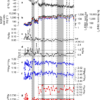The world’s largest lakes are hit by severe lake heat waves—when water temperatures soar far above normal—six times as frequently as they were about two decades ago, according to a new study. Nearly all severe lake heat waves occurring over the past 20 years were due in some part to climate change, and could become between three and 25 times more likely by the end of the century, according to the new research.
A new study analyzed over two decades of surface temperature data from the world’s largest lakes to find out how frequently lake heat waves occur and modeled how much anthropogenic climate change has contributed to their occurrence.
Researchers found severe lake heat waves are twice as likely to occur, on average, as they were during a pre-industrial climate. Lake heat waves can change water conditions, stress aquatic plants and animals, and lead to algae blooms and other water quality issues.
The study was published in the AGU journal Geophysical Research Letters. The study is the first to quantify how anthropogenic (human-induced) climate change has influenced lake heat waves, offering a critical new perspective on one way the world’s lakes are responding to the warming climate.
“What really stood out was the magnitude of human contribution: Most of the severe lake heat waves we looked at had a significant anthropogenic imprint,” said lead study author R. Iestyn Woolway, a climate scientist at Bangor University in Wales. Unlike humans, who can get into air conditioning or construct emergency shade, “there’s no escape for aquatic organisms when they are exposed to these extreme temperatures,” he said.
“It’s a welcome addition to the attribution of anthropogenic impacts on lakes,” said Luke Grant, a data scientist at Vrije Universiteit Brussel, who was not involved in the study. “It fills an evidentiary gap, looking at the influence of temperature extremes on lakes.” The finding that most heat waves have some human influence, Grant added, is “striking.”
Anthropogenic contribution
The increase in remotely sensed data over the past decade has made studies like this one possible, allowing scientists to move away from single-lake studies to tackling global-scale changes in similar ecosystems, said Woolway. The researchers analyzed lake surface temperature data from the European Space Agency from 78 lakes that were large enough to sample temperatures from multiple points and spanning 1995 to 2019.
Woolway and his co-authors looked for lake heat waves of varying intensities, but limited their attribution analysis to “severe” or “extreme” heat waves.
To determine heat wave severity, the researchers analyzed surface temperature anomalies, or how much warmer temperatures are compared to normal conditions. A severe heat wave sees lake surface temperatures that soar well above the top 10% of all observed temperatures. Generally, if humans are feeling the heat, the lakes are, too, said Woolway.
The researchers paired historical temperature data with climate models from the Intersectoral Impact Model Intercomparison Project, a large community effort to simulate lake responses to climate change, to estimate how much human climate change has contributed to observed lake heat waves, and to predict how frequently lake heat waves will occur over the next century.
The researchers found that severe and extreme lake heat waves may be three times more likely at 1.5 degrees Celsius of global warming above pre-industrial temperatures, which was the goal set under the Paris Agreement. Under a 3 degree Celsius global warming scenario, as could occur this century with minimal reductions in greenhouse gas emissions, severe lake heat waves will be up to 25 times more likely, relative to the likelihood of these events in a pre-industrial climate. Anthropogenic contributions were also higher in tropical lakes, Woolway said, mirroring other studies that have found lower-latitude regions bearing the brunt of climate change impacts.
In hot water
Because the study only looked at large lakes, which can be more resistant to changes and severe heat waves, the study may actually be a conservative estimate of how frequently severe lake heat waves hit.
“When we scale these findings to a global scale, the results could be much worse,” Woolway said.
Lake heat waves can be detrimental to ecosystems in several ways. For organisms who live within a narrowly defined temperature regime, even small changes in water temperature can be a death sentence. Warmer waters also mean more evaporation and less mixing, as the lake’s water becomes stratified with hot water on top and cooler water trapped below. Both of these effects can mean less oxygen, which can stress lake dwellers like fish who need to breathe.
As the field of lake heat waves progresses, Grant said, pairing improved datasets with studies on heat refuges for lake dwellers could refine predictions of lake ecosystems’ responses to heat.
“The only way to deal with this is to reduce global warming. If temperatures continue to increase, lake heat waves will get progressively worse,” Woolway said.
More information:
R. Iestyn Woolway et al, Severe Lake Heatwaves Attributable to Human‐Induced Global Warming, Geophysical Research Letters (2022). DOI: 10.1029/2021GL097031
Provided by
American Geophysical Union
Citation:
Climate change drives rise in extreme lake water temperatures (2022, February 24)



